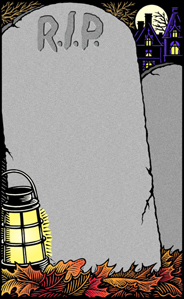
Mar 25, 2013
Leave ’em Laughing
by Leanne Lippincott-Wuerthele
It may seem like a strange leisure time activity, but I enjoy strolling through cemeteries.
Tombstones are mentioned in the Bible as early as Genesis. “Jacob set up a stone monument over Rachel’s grave, and it can be seen there to this day” (Genesis 35:20, New Living Translation).
Absalom, King David’s third and favorite son, had three sons and one daughter, but apparently the sons died at an early age. “During his lifetime Absalom had taken a pillar and erected it in the King’s Valley as a monument to himself, for he thought, ‘I have no son to carry on the memory of my name.’ He named the pillar after himself, and it is called Absalom’s Monument to this day” (2 Samuel 18:18, NIV).
However, that “pillar” wasn’t Absalom’s grave marker. His tomb is situated on the eastern slope of the Kidron Valley, on the east side of Jerusalem. At 20-feet high and 24-feet square, it’s vastly more impressive than any meager tombstone.
When I walk through the cemetery on the north edge of Milton, Wis., memories flood my mind and heart.
Because my feet shuffle down its gravel roads in the spring, leave flattened grassy footsteps in the summer, and crunch brittle leaves in the fall, I know where the final resting places of many Miltonians are located—including those of such faithful SDBs as Dr. Forrest Branch, and Prof. Herbert Crouch and his wife, Virginia.
I realize that these burial sites are empty, housing only tattered earthly tents. Whenever I walk past my first husband’s grave, I’m acutely aware Denny isn’t there, and I find that comforting.
Wandering through cemeteries can conjure up heartwarming memories while providing interesting insights into the lives of complete strangers. Surprisingly, cemeteries can also be sources of humor. Here are a few of the funny—and sometimes profound—epitaphs actually on headstones:
A Mr. Aikle is buried in East Dalhousie Cemetery in Nova Scotia. His tombstone reads, “Here lies Ezekial Aikle. Age 102. The Good Die Young.”
Lester Moore, a Wells Fargo station agent in the 1880s, is buried at Boot Hill Cemetery in Tombstone, Ariz. His marker reads, “Here lies Lester Moore. Four slugs from a .44. No Les. No More.”
A grave marker in a Ruidoso, N.M., cemetery reads, “Here lies Johnny Yeast. Pardon me for not rising.”
An epitaph in Thurmont, Md., says, “Here lies an Atheist. All dressed up and no place to go.”
An accident led to this epitaph in a Uniontown, Pa., cemetery: “Here lies the body of Jonathan Blake. Stepped on the gas instead of the brake.”
Silver City, Nev.: “Here lays Butch, we planted him raw. He was quick on the trigger, but slow on the draw.”
Anna Wallace’s marker in Ribbesford, England, reads, “The children of Israel wanted bread, and the Lord sent them manna. Clark Wallace wanted a wife, and the Devil sent him Anna.”
One English lawyer’s epitaph declares, “Sir John Strange. Here lies an honest lawyer, and that is Strange.”
Anna Hopewell’s gravestone in Enosburg Falls, Vt., reads, “Here lies the body of our Anna, done to death by a banana. It wasn’t the fruit that laid her low, but the skin of the thing that made her go.”
Found in a cemetery in Hartscombe, England: “On the 22nd of June, Jonathan Fiddle went out of tune.”
One of my favorite epitaphs—with a “footnote”—is also located in England:
“Remember man, as you walk by, as you are now, so once was I. As I am now, so shall you be. Remember this and follow me.”
Underneath those lines, someone added: “To follow you, I’ll not consent, until I know which way you went.”


